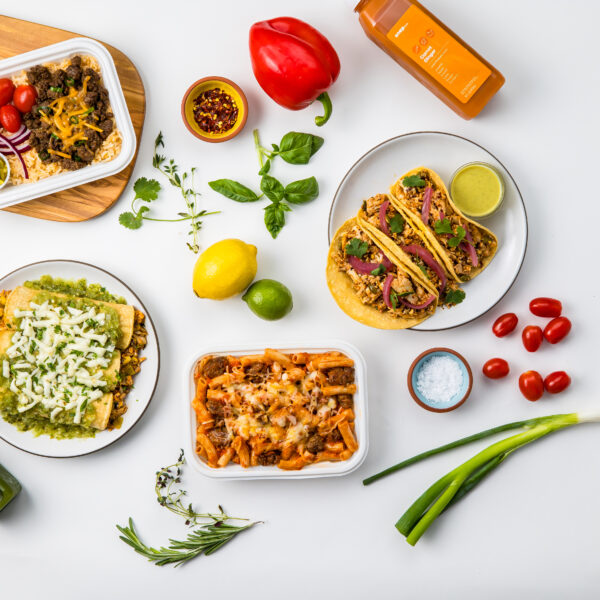Here at Snap Kitchen, we have a totally gluten-free menu, which means everything we deliver and sell is gluten-free. For a food company or restaurant, that’s a pretty rare thing. Today, we want to talk about why.
What is gluten?
Gluten is a grain protein mainly found in wheat but also in barley and rye. What does that mean in practical terms? You can find it in bread, crackers, cereals, grains, pizza, pasta, wraps, rolls, and almost all packaged & highly-processed foods. It’s a staple in the standard American diet, which is why if you’re trying to avoid it, it can be pretty hard to eat out or even find something to pick up at the store. We know it’s not easy to find truly healthy food options without spending hours in the kitchen, so we’re here to help you cross one item off your ever-growing to-do list.
How can gluten be problematic?
Of course, this can vary by person, but there’s research showing that gluten causes intestinal permeability, or leaky gut syndrome. When you eat gluten, it travels through your stomach and into your small intestine, where its presence initiates the release of zonulin. Zonulin signals the tight junctions of your intestinal wall to open. As their name implies, tight junctions are meant to stay sealed, making sure that the foods that enter your digestive tract never make their way to other parts of your body.
If gluten consumption is occasional and you don’t have celiac disease, your tight junctions can generally repair the damage after the meal. However, in our modern food environment, most people consume gluten on a daily basis. Eventually, your tight junctions lose the ability to repair the damage and they remain open, leading to a leaky gut. Leaky gut syndrome can lead to a host of other issues, including autoimmune disease.
Once you’ve got a leaky gut, your immune system tends to respond to the gluten you’re still consuming with increasing alarm, causing chronic inflammation. Your body begins responding to all gluten (and often other food particles), as foreign invaders. Eventually, your body’s own tissues can end up being attacked, leading to an autoimmune disease.
How do I know if I have an issue with gluten?
For some, a celiac disease diagnosis makes it very clear that gluten must be avoided. Celiac disease is an autoimmune condition in which people can’t eat gluten because any amount permanently damages their small intestine. Recently, though, there’s been research that even those without celiac disease can have issues with gluten. For some, this manifests as non-celiac gluten sensitivity and others just feel better without (or simply reducing) this inflammatory protein.
You can test this for yourself by cutting out gluten for a month or more, then reintroducing it to see how you feel. Pay attention to how you feel when you stop eating it. Did you previously have digestive issues, joint pain, recurring headaches, feelings of anxiety or depression, or other symptoms that resolved when you removed gluten? You may even notice that certain biochemical markers (like cholesterol or triglycerides) improve when you stop eating gluten. Keep in mind that if you do want to get tested for celiac disease, you need to be eating gluten to avoid a false negative result.
What should I eat instead of gluten?
The key here is to not replace all of your favorite gluten-filled foods with gluten-free alternatives. If you scan the gluten-free aisle at your local supermarket and read the product labels, you’ll see that many of them have an ingredient list that’s a mile long. Lots of gluten-free products have just as many carbohydrates and yucky ingredients as their gluten-filled counterparts. There are certain brands that do a great job, with simple ingredient lists and nourishing products that are fine to incorporate into your overall diet. However, always keep the bulk of what you consume focused on fruits and vegetables, high-quality protein, and healthy fats, enjoying gluten-free bread or desserts occasionally.
As a gluten-free meal prep delivery company we love replicating comfort food faves with nourishing gluten-free options that are both delicious and nutritious.
Some of our favorite gluten-free no-prep meals:
- Cacio e Pepe with Rosemary Chicken
- Baked Ziti with Italian Beef Sausage
- Peach BBQ Brisket with Loaded Cauliflower
- Wagyu Fajita Bowl
- Chicken Enchiladas with Tomatillo Salsa
- Chicken Carnitas Tacos with Salsa Verde
We want to hear from you! Do you love Snap because we’re gluten-free, or do you love us despite the fact that we’re gluten-free?





Leave a Reply
4 Comments
This is amazing I absolutely love that you are informing people on the affects of gluten because not a lot of people know or believe that gluten can be a culprit to super harsh symptoms!! Thank you so much for sharing!!
Thanks for the great feedback Morgan! We’re so glad it was helpful.
I love the fact that you are gluten free. I’m not celiac but got pretty sick a few years ago. My GI doc recommended doing whole30 to diagnose and I went on snap kitchen while 30 plan for two months! It helped me figure out my gluten intolerance and I’ve been hooked ever since. Thank you for making it easy and stress-free to meal prep with my busy schedule.
Thank you for this amazing feedback and comment Samantha! I’m so glad that your GI doc recommended the Whole30 and that Snap was able to help along the journey. I’m actually going to send you an email now to hear more about your experience!